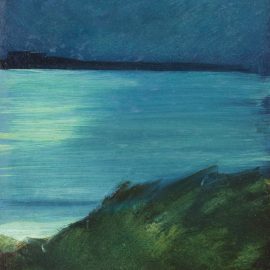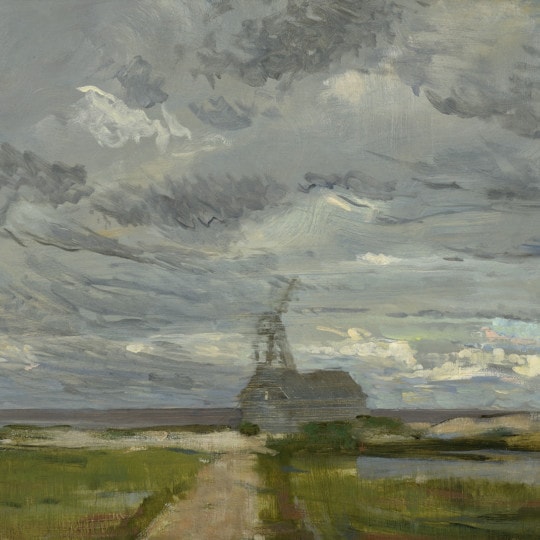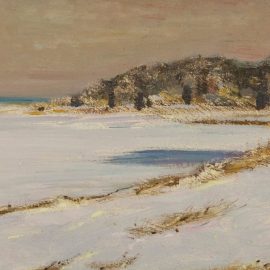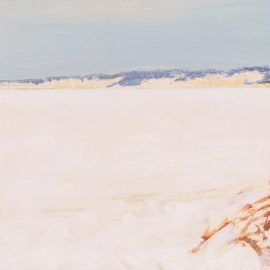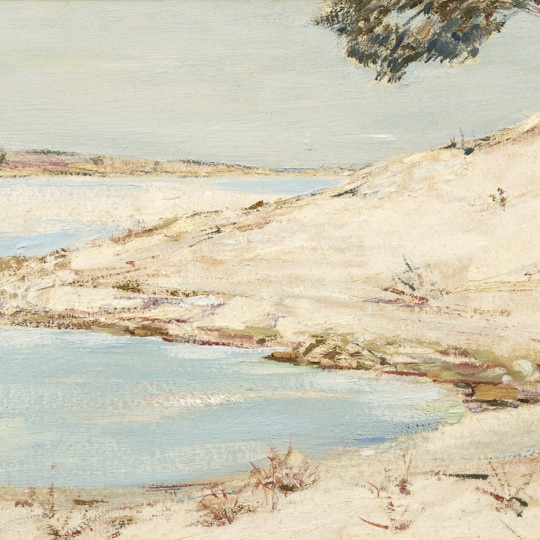Artist Biography
Henry Prellwitz was a leading artist of the Peconic artists’ colony on Long Island’s North Fork; he is known for his figurative paintings and landscapes.
By Jenny Lyubomudrova
I. Biography
II. Chronology
III. Collections
IV. Exhibitions
V. Memberships
VI. Notes
VII. Suggested Resources
I. Biography
Henry Prellwitz was born on November 13, 1865 on 25th Street in New York City. He was one of the five sons of Randolph and Margaretha Prellwitz, immigrants from Eastern Prussia and Mainz, Germany.
Henry was an intelligent and precocious student, skipping several grades and graduating early from public school. He enrolled at the City College of New York at the age of fourteen to study classical literature. It was at
Henry Prellwitz was a leading artist of the Peconic artists’ colony on Long Island’s North Fork; he is known for his figurative paintings and landscapes.
By Jenny Lyubomudrova
I. Biography
II. Chronology
III. Collections
IV. Exhibitions
V. Memberships
VI. Notes
VII. Suggested Resources
I. Biography
Henry Prellwitz was born on November 13, 1865 on 25th Street in New York City. He was one of the five sons of Randolph and Margaretha Prellwitz, immigrants from Eastern Prussia and Mainz, Germany.
Henry was an intelligent and precocious student, skipping several grades and graduating early from public school. He enrolled at the City College of New York at the age of fourteen to study classical literature. It was at City College that Henry received his first formal instruction in art, studying under Professor Solomon Wolff and Leigh Hunt. The young artist began attending exhibitions at the National Academy of Design, and shortly thereafter enrolled in the newly founded Art Students League of New York. At the age of seventeen, he was one of the youngest students in attendance.[1]
Prellwitz was admitted to the league’s antique class, taught by impressionist Thomas Wilmer Dewing. Dewing became his mentor and in 1885, took him on as apprentice. The following year, impressed by a drawing of lace that Prellwitz had done for Dewing, the architect Stanford White hired him to produce decorative drawings. In the summer of 1886, Dewing invited Prellwitz to visit his country home in Cornish, New Hampshire, which was already beginning to establish itself as an artists’ colony. Prellwitz recalled this first visit to country as “the beginning of perfect wonders. A New York kid to be thrown into that wonderland.”[2]
Dewing encouraged Prellwitz to continue his artistic studies abroad, and in 1887, he left for Paris to study at the Académie Julian. Prellwitz remained in Europe through the 1889 Universal Exposition in Paris. In 1890, Prellwitz returned to New York and the design work he had begun under Stanford White, working for Francis Lathorp as a designer for Tiffany Glass Company and also as an assistant for Augustus Saint-Gaudens. In 1892, he began to exhibit his paintings at the National Academy of Design and at the Society of American Artists, where they were met with critical acclaim. The painting Idlewild brought him his first major success that same year when it was shown at the National Academy of Design. Depicting a young boy playing the flute in a field of birds and butterflies, the work was praised for the “grace and refinement in the figure, and a subtlety of color in both figure and sylvan setting, which could only have been derived from the artist himself.”[3] In 1893, Prellwitz won the Third Julius Hallgarten Prize from the National Academy for The Prodigal Son. These early successes earned Prellwitz a reputation as one of America’s most promising figurative painters at a time when the genre was becoming increasingly popular in American art.
Prellwitz took occupancy at a studio in the Holbein Building, directly across from that of the artist Edith Mitchell. The two artists had known each other from their time at the Art Students League, as well as through their studies in Paris. On October 6, 1894, Edith and Henry Prellwitz were married. The following year, the couple built a modest summer residence in Cornish, New Hampshire, rejoining a dynamic community of painters, writers, and musicians. The natural beauty of Cornish and its surrounding landscapes were a source of inspiration for the artists. During summers there, Prellwitz painted numerous views of Mount Ascutney. Joined by Edith, Dewing, and Saint-Gaudens, Prellwitz took regular expeditions to the peak of the mountain, sometimes spending nights in the open air.
The following years were marked by several successes for Henry Prellwitz. In 1897, he was elected to the Society of American Artists. He later received critical praise both for his tonalist work Dusk and for the masterful composition of the large-scale painting Dante and Virgil. In 1899, the Prellwitzes were honored by an important joint exhibition at the Charcoal Club in Baltimore and the Pratt Institute in Brooklyn. The show was praised as “the finest that has been on public exhibition in this city for some years.”[4]
In 1898, the Prellwitzes’ cottage at Cornish was struck by lightning and lost to the subsequent fire, leading the couple to relocate their summer residence to Peconic, on Long Island’s North Fork, which provided greater proximity to New York City than Cornish. The artists fell in love with the unspoiled beauty of Long Island, and that fall, purchased their summer rental house and built a studio behind it. Both Henry and Edith actively participated in the Peconic community, which was gaining a reputation as a haven for artistic professionals, in contrast to the more socially fashionable South Fork.
Henry continued to exhibit his work at the Society of American Artists, as well as at the National Academy of Design. In 1904, he won the St. Louis Exposition award for the painting Lotus and Laurel.[5] Three years later, he won the Thomas B. Clarke Prize at the National Academy of Design for the work Venus.[6]
The turn of the century coincided with the emergence of modernism in American art, with the 1913 Armory Show in New York marking the rise of the movement. In contrast, Henry Prellwitz actively rejected modernism in his own art. He explained, “I am not ready for it yet. … I do not like Matisse or Cezanne.”[7] As modernism continued to grow in popularity and acclaim, Prellwitz increasingly focused on his more academic figurative and landscape work. The community in Peconic provided the Prellwitzes with a creative retreat. While he reduced the frequency with which he exhibited his work, Prellwitz continued painting and working freely in Peconic. His grandson, Sam Prellwitz, recalls that his grandfather “was never pressured to paint, and he painted for himself. But when an inspiration hit … [he painted] on anything with a flat surface, from canvas to Sheetrock to beaverboard, often on both sides.”[8] Henry Prellwitz was known to have said “I paint color, compose shapes and give a strong impression. It’s up to the viewer to fill in the rest and make their own picture.”[9]
In 1911, Prellwitz bought an early nineteenth-century house in Aqueboque and had it moved to Indian Neck, near the summer home of Irving Ramsay Wiles. Prellwitz named the new house High House Josh. The following year, Henry and Edith sold their home in New York City and began to live in their new home in Peconic year round. Near the house, they built two adjacent but separate studios. During this time, Prellwitz devoted himself to painting landscapes and marines scenes. He particularly enjoyed painting winter scenes, drawn to the simplicity and limited palette of the wintry hues of the frozen bay.[10] After eleven years in Peconic, the Prellwitzes purchased another home in New York City, but the following decade again returned to live in Peconic year round.
Henry Prellwitz passed away in 1940 in East Greenwich, Rhode Island, where Henry and Edith were visiting their son and his family. Several months later, Edith poignantly wrote of Henry’s passing: “Henry died six months ago today at noon. … It was snowing gently … when they buried him. … A light beautiful snow–and a bird near the grave broke into song. Everyone remembers it, not me alone. It was all as he would have liked it–quiet and beautiful.” [11]
II. Chronology
1865 Born in New York, New York on November 13
1879–82 Attends classes at the City College of New York
1882–87 Attends classes at the Art Students League in New York
1887 In October, travels to Paris to study at the Académie Julian
1888 Travels to Germany
1889 Visits the Paris Exposition
1890 Returns to New York in the spring; works on stained glass designs for Tiffany Glass Co.
1891 Appointed recording secretary, Board of Control at the Art Students League
1892 Establishes a studio in the Holbein Studio Building in New York; exhibits for the first time at the National Academy of Design
1893 Awarded the Third Hallgarten Prize for The Prodigal Son at the National Academy of Design
1893–1912 Teaches at the Pratt Institute, Brooklyn
1894 On October 6, marries Edith Mitchel; the two collaborate on a mural competition for the Municipal Art Society; exhibits for the first time at the Society of American Artists
1894–98 Appointed director of the Art Students League
1895 Builds a summer home in the artists’ colony in Cornish, New Hampshire
1896 Son, Edwin Mitchell Prellwitz, born on July 19
1897 Elected to the Society of American Artists
1898 The summer cottage in Cornish is destroyed by lightning
1899 Rents a summer house in Peconic, Long Island; purchases the house and opens a studio; Henry and Edith have joint retrospectives at the Charcoal Club in Baltimore, January 20–28, which goes on to travel to the E. & H. Pratt Library Building and Art Gallery, Pratt Institute, Brooklyn, February 6–March 4
1900 Exhibits at the 57th Street Gallery
1901 Exhibits Dante and Virgil and An Idyll at the Pan-American Exposition in Buffalo, New York
1904 Receives the Silver Medal for Lotus and Laurel at the St. Louis Exposition
1905 Opens two studios in New York, New York
1906 Begins post as secretary for the Society of American Artists; elected member of the National Academy of Design
1907 Awarded the Thomas B. Clarke Prize for Venus, National Academy of Design
1911 Henry and Edith purchase an abandoned house in Aquebogue, Long Island, which they dismantle and move to Peconic
1912 Elected to full membership at the National Academy of Design
1913–14 Focuses on painting local landscapes in Peconic, while continuing to exhibit work at the National Academy of Design
1924–38 Opens another studio in New York, New York
1928–40 Serves as treasurer of the National Academy of Design
1940 On March 13, dies in East Greenwich, Rhode Island
III. Collections
National Academy of Design, New York, New York
Pennsylvania Academy of the Fine Arts, Philadelphia, Pennsylvania
Southold Historical Society, New York
Virginia Museum of Fine Arts, Richmond, Virginia
IV. Exhibitions
1892–93, 1894–97, 1907 National Academy of Design
1893–94, 1898, 1903–04 Pennsylvania Academy of Fine Arts, Pennsylvania
1901 Pan American Exposition, Buffalo, New York
1904 St. Louis Exposition, Missouri
V. Memberships
The Century Association
Cornish Colony
Society of American Artists
National Academy of Design, associate 1906, academician 1912
VI. Notes
1. Ronald G. Pisano and Dr. William H. Gerdts, Painters of Peconic: Edith Prellwitz (1864–1944) and Henry Prellwitz (1865–1940) (New York: Spanierman Gallery, LLC, 2002), 14.
2. Ibid., 15.
3. Ibid., 17.
4. Ibid., 24.
5. Marjorie Kaufman, “A New Glimpse of the Heyday of the Peconic Art Colony,” New York Times, May 15, 1995.
6. Pisano and Gerdts, 26.
7. Ibid., 5.
8. Kaufman.
9. Ibid.
10. Pisano and Gerdts, 128.
11. Ibid., 29.
VII. Suggested Resources
“Henry Prellwitz.” In Who Was Who in American Art, 1564–1975: 400 Years of Artists in America. , Edited by Peter H. Falk, 3: 2659. Madison, CT: Sound View Press, 1999.
Pisano, Ronald G. Long Island Landscape Painting 1820–1920. Boston: Little, Brown, and Company, 1985.
Pisano, Ronald G. and Dr. William H. Gerdts. Painters of Peconic: Edith Prellwitz (1864–1944) and Henry Prellwitz (1865–1940). New York: Spanierman Gallery, LLC, 2002.
Henry Prellwitz was a leading artist of the Peconic artists’ colony on Long Island’s North Fork; he is known for his figurative paintings and landscapes.
By Jenny Lyubomudrova
I. Biography
II. Chronology
III. Collections
IV. Exhibitions
V. Memberships
VI. Notes
VII. Suggested Resources
I. Biography
Henry Prellwitz was born on November 13, 1865 on 25th Street in New York City. He was one of the five sons of Randolph and Margaretha Prellwitz, immigrants from Eastern Prussia and Mainz, Germany.
Henry was an intelligent and precocious student, skipping several grades and graduating early from public school. He enrolled at the City College of New York at the age of fourteen to study classical literature. It was at City College that Henry received his first formal instruction in art, studying under Professor Solomon Wolff and Leigh Hunt. The young artist began attending exhibitions at the National Academy of Design, and shortly thereafter enrolled in the newly founded Art Students League of New York. At the age of seventeen, he was one of the youngest students in attendance.[1]
Prellwitz was admitted to the league’s antique class, taught by impressionist Thomas Wilmer Dewing. Dewing became his mentor and in 1885, took him on as apprentice. The following year, impressed by a drawing of lace that Prellwitz had done for Dewing, the architect Stanford White hired him to produce decorative drawings. In the summer of 1886, Dewing invited Prellwitz to visit his country home in Cornish, New Hampshire, which was already beginning to establish itself as an artists’ colony. Prellwitz recalled this first visit to country as “the beginning of perfect wonders. A New York kid to be thrown into that wonderland.”[2]
Dewing encouraged Prellwitz to continue his artistic studies abroad, and in 1887, he left for Paris to study at the Académie Julian. Prellwitz remained in Europe through the 1889 Universal Exposition in Paris. In 1890, Prellwitz returned to New York and the design work he had begun under Stanford White, working for Francis Lathorp as a designer for Tiffany Glass Company and also as an assistant for Augustus Saint-Gaudens. In 1892, he began to exhibit his paintings at the National Academy of Design and at the Society of American Artists, where they were met with critical acclaim. The painting Idlewild brought him his first major success that same year when it was shown at the National Academy of Design. Depicting a young boy playing the flute in a field of birds and butterflies, the work was praised for the “grace and refinement in the figure, and a subtlety of color in both figure and sylvan setting, which could only have been derived from the artist himself.”[3] In 1893, Prellwitz won the Third Julius Hallgarten Prize from the National Academy for The Prodigal Son. These early successes earned Prellwitz a reputation as one of America’s most promising figurative painters at a time when the genre was becoming increasingly popular in American art.
Prellwitz took occupancy at a studio in the Holbein Building, directly across from that of the artist Edith Mitchell. The two artists had known each other from their time at the Art Students League, as well as through their studies in Paris. On October 6, 1894, Edith and Henry Prellwitz were married. The following year, the couple built a modest summer residence in Cornish, New Hampshire, rejoining a dynamic community of painters, writers, and musicians. The natural beauty of Cornish and its surrounding landscapes were a source of inspiration for the artists. During summers there, Prellwitz painted numerous views of Mount Ascutney. Joined by Edith, Dewing, and Saint-Gaudens, Prellwitz took regular expeditions to the peak of the mountain, sometimes spending nights in the open air.
The following years were marked by several successes for Henry Prellwitz. In 1897, he was elected to the Society of American Artists. He later received critical praise both for his tonalist work Dusk and for the masterful composition of the large-scale painting Dante and Virgil. In 1899, the Prellwitzes were honored by an important joint exhibition at the Charcoal Club in Baltimore and the Pratt Institute in Brooklyn. The show was praised as “the finest that has been on public exhibition in this city for some years.”[4]
In 1898, the Prellwitzes’ cottage at Cornish was struck by lightning and lost to the subsequent fire, leading the couple to relocate their summer residence to Peconic, on Long Island’s North Fork, which provided greater proximity to New York City than Cornish. The artists fell in love with the unspoiled beauty of Long Island, and that fall, purchased their summer rental house and built a studio behind it. Both Henry and Edith actively participated in the Peconic community, which was gaining a reputation as a haven for artistic professionals, in contrast to the more socially fashionable South Fork.
Henry continued to exhibit his work at the Society of American Artists, as well as at the National Academy of Design. In 1904, he won the St. Louis Exposition award for the painting Lotus and Laurel.[5] Three years later, he won the Thomas B. Clarke Prize at the National Academy of Design for the work Venus.[6]
The turn of the century coincided with the emergence of modernism in American art, with the 1913 Armory Show in New York marking the rise of the movement. In contrast, Henry Prellwitz actively rejected modernism in his own art. He explained, “I am not ready for it yet. … I do not like Matisse or Cezanne.”[7] As modernism continued to grow in popularity and acclaim, Prellwitz increasingly focused on his more academic figurative and landscape work. The community in Peconic provided the Prellwitzes with a creative retreat. While he reduced the frequency with which he exhibited his work, Prellwitz continued painting and working freely in Peconic. His grandson, Sam Prellwitz, recalls that his grandfather “was never pressured to paint, and he painted for himself. But when an inspiration hit … [he painted] on anything with a flat surface, from canvas to Sheetrock to beaverboard, often on both sides.”[8] Henry Prellwitz was known to have said “I paint color, compose shapes and give a strong impression. It’s up to the viewer to fill in the rest and make their own picture.”[9]
In 1911, Prellwitz bought an early nineteenth-century house in Aqueboque and had it moved to Indian Neck, near the summer home of Irving Ramsay Wiles. Prellwitz named the new house High House Josh. The following year, Henry and Edith sold their home in New York City and began to live in their new home in Peconic year round. Near the house, they built two adjacent but separate studios. During this time, Prellwitz devoted himself to painting landscapes and marines scenes. He particularly enjoyed painting winter scenes, drawn to the simplicity and limited palette of the wintry hues of the frozen bay.[10] After eleven years in Peconic, the Prellwitzes purchased another home in New York City, but the following decade again returned to live in Peconic year round.
Henry Prellwitz passed away in 1940 in East Greenwich, Rhode Island, where Henry and Edith were visiting their son and his family. Several months later, Edith poignantly wrote of Henry’s passing: “Henry died six months ago today at noon. … It was snowing gently … when they buried him. … A light beautiful snow–and a bird near the grave broke into song. Everyone remembers it, not me alone. It was all as he would have liked it–quiet and beautiful.” [11]
II. Chronology
1865 Born in New York, New York on November 13
1879–82 Attends classes at the City College of New York
1882–87 Attends classes at the Art Students League in New York
1887 In October, travels to Paris to study at the Académie Julian
1888 Travels to Germany
1889 Visits the Paris Exposition
1890 Returns to New York in the spring; works on stained glass designs for Tiffany Glass Co.
1891 Appointed recording secretary, Board of Control at the Art Students League
1892 Establishes a studio in the Holbein Studio Building in New York; exhibits for the first time at the National Academy of Design
1893 Awarded the Third Hallgarten Prize for The Prodigal Son at the National Academy of Design
1893–1912 Teaches at the Pratt Institute, Brooklyn
1894 On October 6, marries Edith Mitchel; the two collaborate on a mural competition for the Municipal Art Society; exhibits for the first time at the Society of American Artists
1894–98 Appointed director of the Art Students League
1895 Builds a summer home in the artists’ colony in Cornish, New Hampshire
1896 Son, Edwin Mitchell Prellwitz, born on July 19
1897 Elected to the Society of American Artists
1898 The summer cottage in Cornish is destroyed by lightning
1899 Rents a summer house in Peconic, Long Island; purchases the house and opens a studio; Henry and Edith have joint retrospectives at the Charcoal Club in Baltimore, January 20–28, which goes on to travel to the E. & H. Pratt Library Building and Art Gallery, Pratt Institute, Brooklyn, February 6–March 4
1900 Exhibits at the 57th Street Gallery
1901 Exhibits Dante and Virgil and An Idyll at the Pan-American Exposition in Buffalo, New York
1904 Receives the Silver Medal for Lotus and Laurel at the St. Louis Exposition
1905 Opens two studios in New York, New York
1906 Begins post as secretary for the Society of American Artists; elected member of the National Academy of Design
1907 Awarded the Thomas B. Clarke Prize for Venus, National Academy of Design
1911 Henry and Edith purchase an abandoned house in Aquebogue, Long Island, which they dismantle and move to Peconic
1912 Elected to full membership at the National Academy of Design
1913–14 Focuses on painting local landscapes in Peconic, while continuing to exhibit work at the National Academy of Design
1924–38 Opens another studio in New York, New York
1928–40 Serves as treasurer of the National Academy of Design
1940 On March 13, dies in East Greenwich, Rhode Island
III. Collections
National Academy of Design, New York, New York
Pennsylvania Academy of the Fine Arts, Philadelphia, Pennsylvania
Southold Historical Society, New York
Virginia Museum of Fine Arts, Richmond, Virginia
IV. Exhibitions
1892–93, 1894–97, 1907 National Academy of Design
1893–94, 1898, 1903–04 Pennsylvania Academy of Fine Arts, Pennsylvania
1901 Pan American Exposition, Buffalo, New York
1904 St. Louis Exposition, Missouri
V. Memberships
The Century Association
Cornish Colony
Society of American Artists
National Academy of Design, associate 1906, academician 1912
VI. Notes
1. Ronald G. Pisano and Dr. William H. Gerdts, Painters of Peconic: Edith Prellwitz (1864–1944) and Henry Prellwitz (1865–1940) (New York: Spanierman Gallery, LLC, 2002), 14.
2. Ibid., 15.
3. Ibid., 17.
4. Ibid., 24.
5. Marjorie Kaufman, “A New Glimpse of the Heyday of the Peconic Art Colony,” New York Times, May 15, 1995.
6. Pisano and Gerdts, 26.
7. Ibid., 5.
8. Kaufman.
9. Ibid.
10. Pisano and Gerdts, 128.
11. Ibid., 29.
VII. Suggested Resources
“Henry Prellwitz.” In Who Was Who in American Art, 1564–1975: 400 Years of Artists in America. , Edited by Peter H. Falk, 3: 2659. Madison, CT: Sound View Press, 1999.
Pisano, Ronald G. Long Island Landscape Painting 1820–1920. Boston: Little, Brown, and Company, 1985.
Pisano, Ronald G. and Dr. William H. Gerdts. Painters of Peconic: Edith Prellwitz (1864–1944) and Henry Prellwitz (1865–1940). New York: Spanierman Gallery, LLC, 2002.

